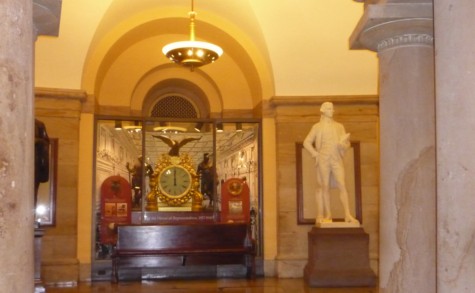 Over the last two weeks, we’ve looked at one of the oldest urban legends related to the Capitol: that of the keeper of the crypt. One of the interesting features of urban legends is their ability to change over time, as people either wish to emphasize or de-emphasize various aspects of the story to fit their agenda.
Over the last two weeks, we’ve looked at one of the oldest urban legends related to the Capitol: that of the keeper of the crypt. One of the interesting features of urban legends is their ability to change over time, as people either wish to emphasize or de-emphasize various aspects of the story to fit their agenda.
In July 1877, the Atlantic Monthly published a piece entitled “A Century of Congress,” written by the man representing Ohio’s 19th District. Within it was a short paragraph with the following story: “In the crypt constructed under the dome of the Capitol, as the resting-place for the remains of Washington, a guard was stationed, and a light was kept burning for more than half a century. Indeed, the office of keeper of the crypt was not abolished until after the late war.”
The author, who would become the 20th President of the United States less than three years later, was James A. Garfield. He had added (or, more accurately, distorted) one fact from the original story, in that he had made the “one gas burner” that was originally mentioned into a “light that was kept burning for more than half a century.” Numerous tellings of the tale include this tidbit.
Another source indicates that the Keeper of the Crypt did not even know where the crypt was – a complete fabrication. Frequently, the cost of the position is mentioned, though almost invariably set at a remarkably high level. In fact, the keeper, while not poorly paid, had a salary that was in line with others doing similar jobs – and the pay went up over the years, as would be expected. The most frequent addition is that the position had survived as long as it did because no one was willing to admit that they had no idea what the meaning of “keeper of the crypt” was. Harper’s Magazine wrote in 1870 that the position remained so long “because no member had the moral courage to confess his ignorance of the meaning of the word. The jokers say that many members thought it was some mysterious object, like the mace, without which Congress would not be Congress.” This, of course, made Benjamin Butler even more of a hero, the straight-talking guy who is smarter than everyone around him. Another variation has Butler “sapping and mining one day in an almost forgotten catacomb” under the Capitol, when he is confronted with “a spectral-looking individual.” Butler asks who he is, and is told “I am the keeper of the General Washington crypt.” Butler remonstrates and investigates, and discovers that this has been ongoing for 65 years, “while the ‘patriotism’ of successive secretaries of the treasury forbade inquiry into the subject.”
In fact, the number of years that this went on varies widely, from 30 to 85 years. Obviously, the longer time span makes the story more outrageous, but the fact is that the crypt was not built until 1827, thus it was impossible for the keeper of the crypt to have been there for more than 30 years.
And finally, there’s the question of the name. In almost every single retelling of the tale, the name of the position is given as “Keeper of the crypt,” which is a name that was never attached to it in reality. After all, the original Tribune report has it right with “superintendent,” so there’s no reason that everyone got it wrong thereafter. One possibility is that the culprit is the Harper’s article reference earlier. It is one of the earliest to reprint the story in a magazine, and maybe that’s where the error came in and has been repeated ever since.
That the story is still not entirely dead is shown in Dan Brown’s book The Lost Symbol:
“The hole in the floor [in the Capitol Rotunda],” Langdon told them, “was eventually covered, but for a good while, those who visited the Rotunda could see straight down to the fire that burned below.”
Sato turned. “Fire? In the U.S. Capitol?”
“More of a large torch, actually – an eternal flame that burned in the crypt directly beneath us. It was supposed to be visible through the hole in the floor, making this room a modern Temple of Vesta. This building even had its own vestal virgin – a federal employee called the Keeper of the Crypt-who successfully kept the flame burning for fifty years, until politics, religion, and smoke damage snuffed out the idea.”
In short, this is a story that has become part of our shared heritage – and won’t go away any time soon.
If you’re interested in following the progress of my scandal book as it makes its way through the publisher, as well as reading about tangentially-connected scandals, as well as the opportunity to get a good deal on the book, “like” my book’s Facebook page at www.facebook.com/RobertPohlAuthor

